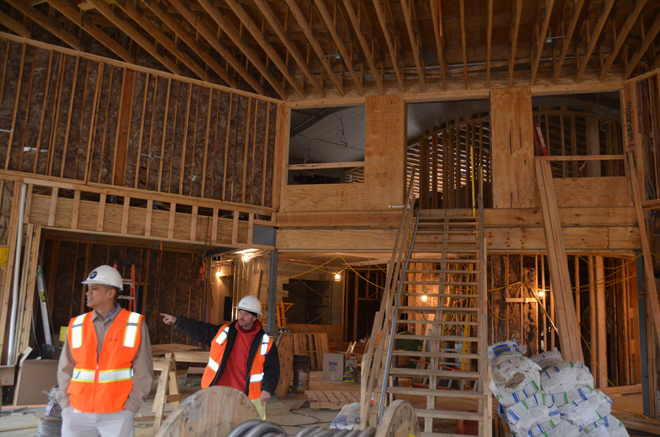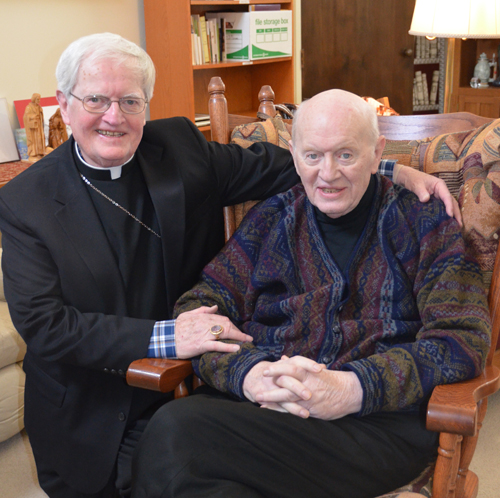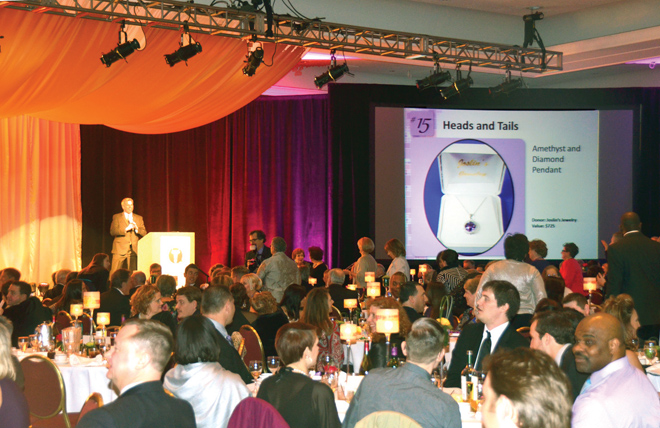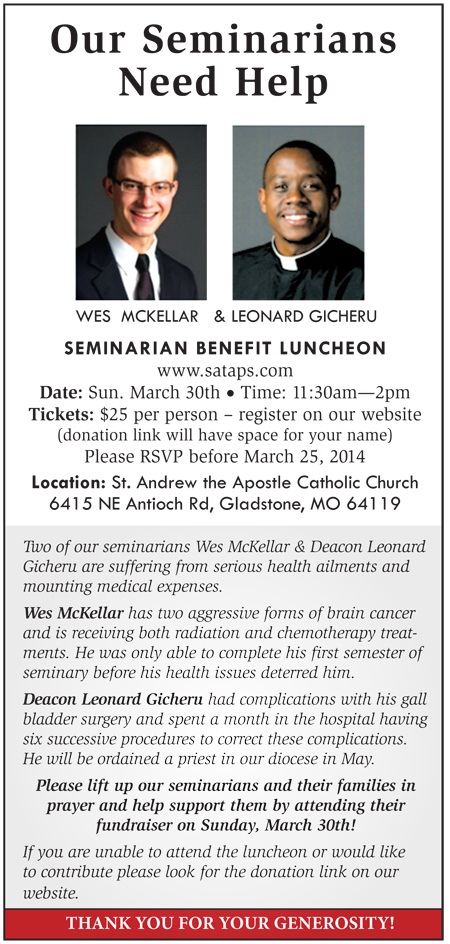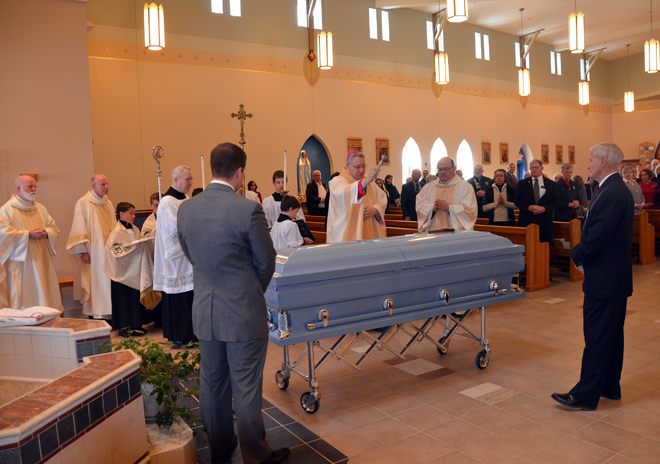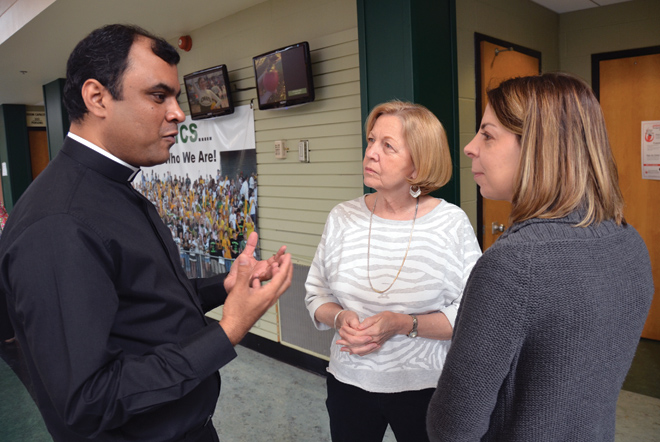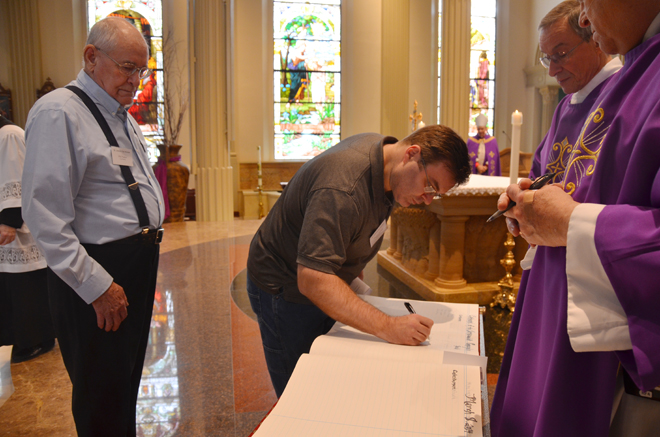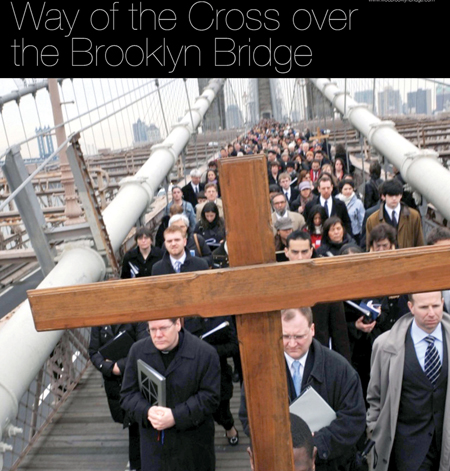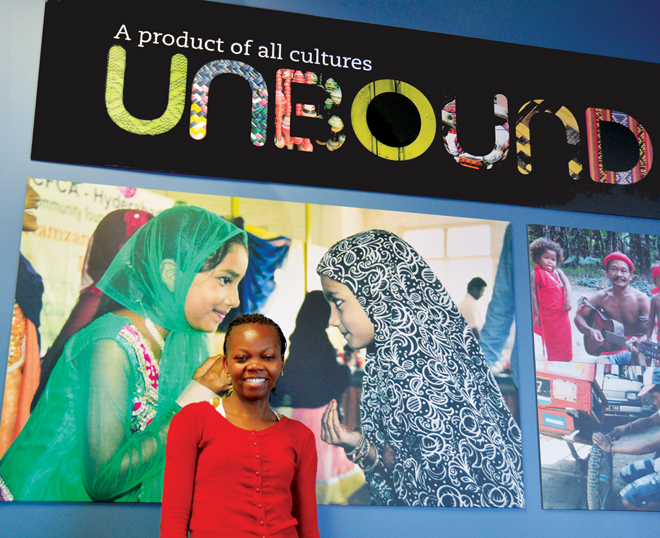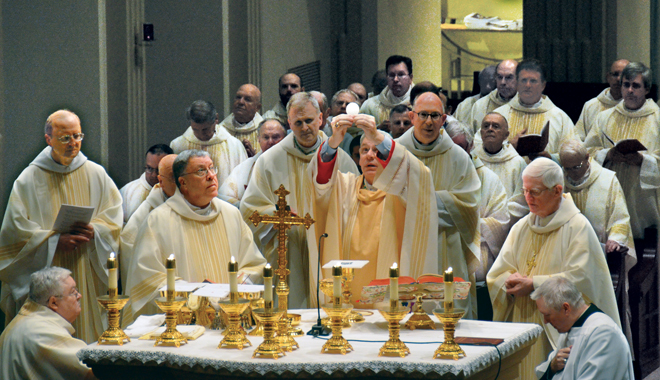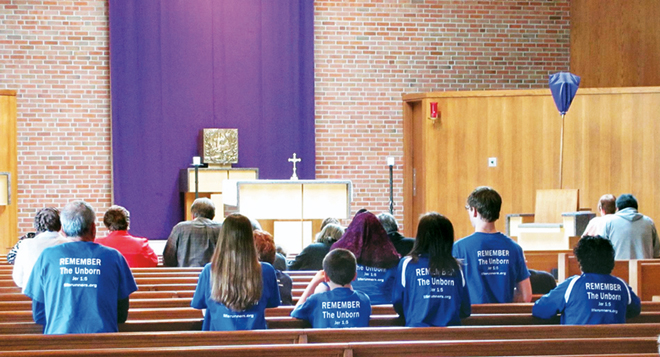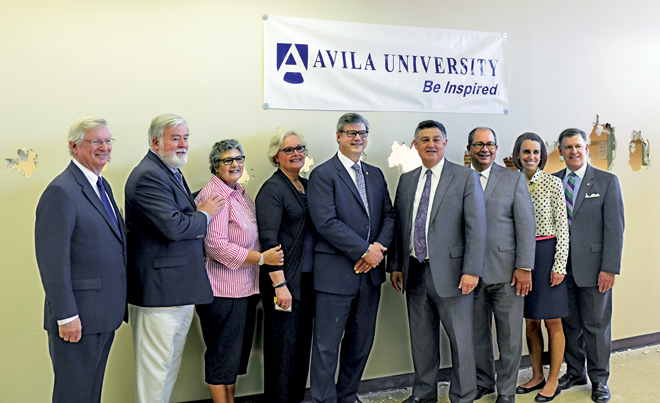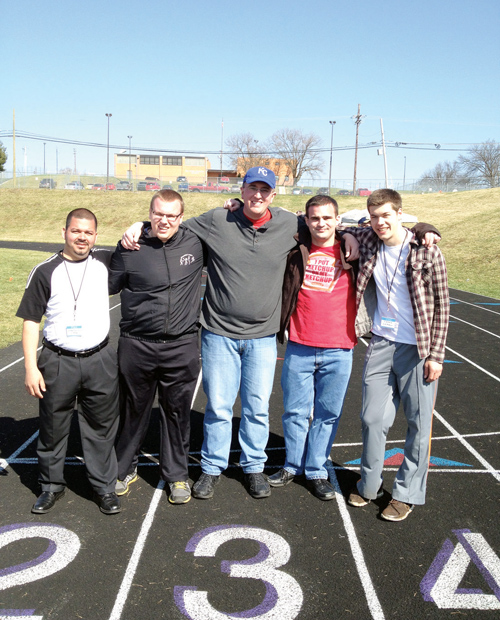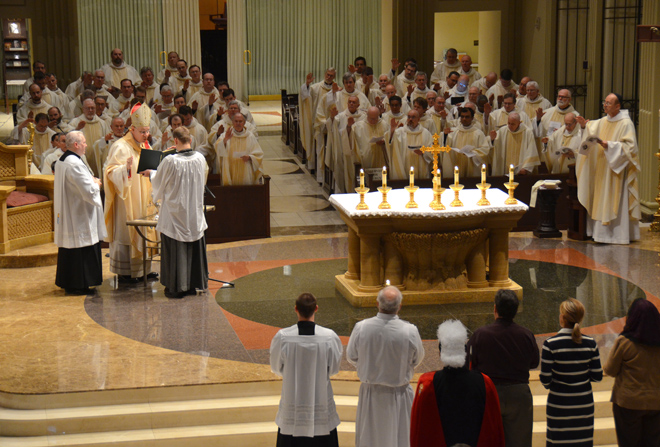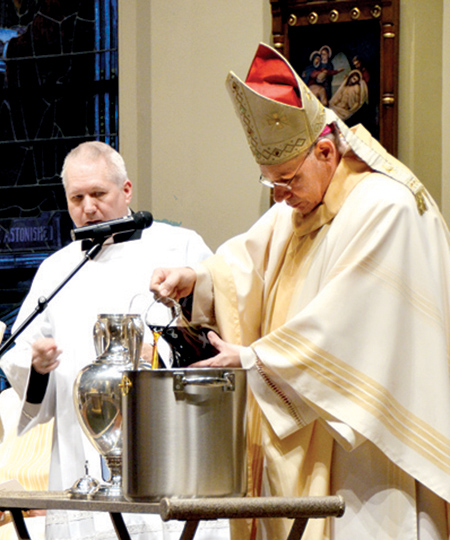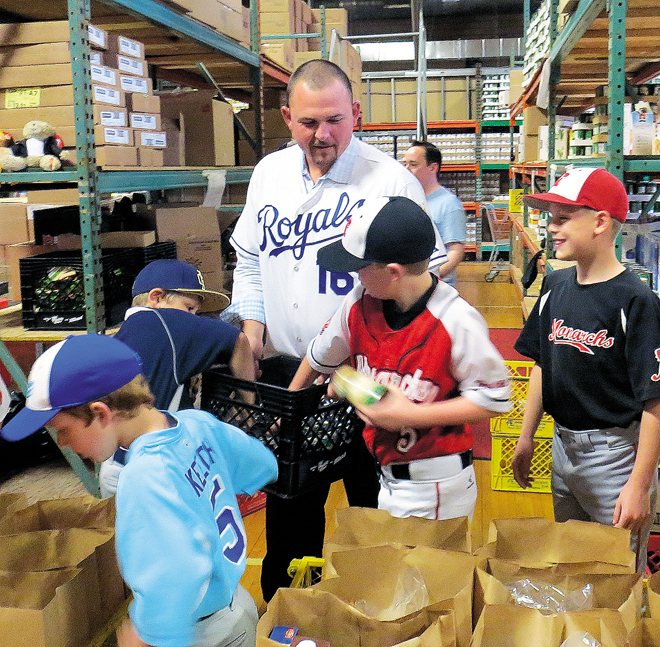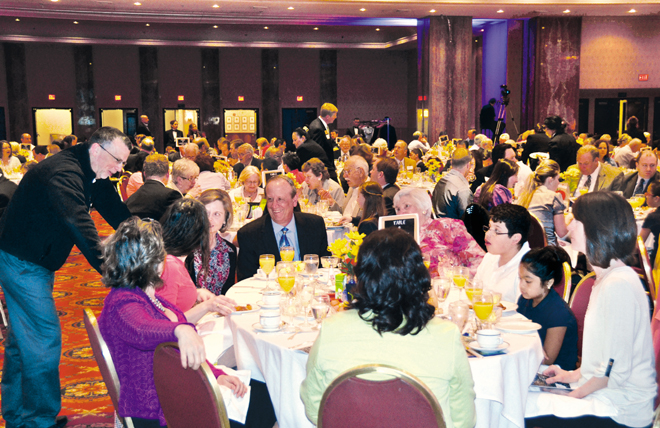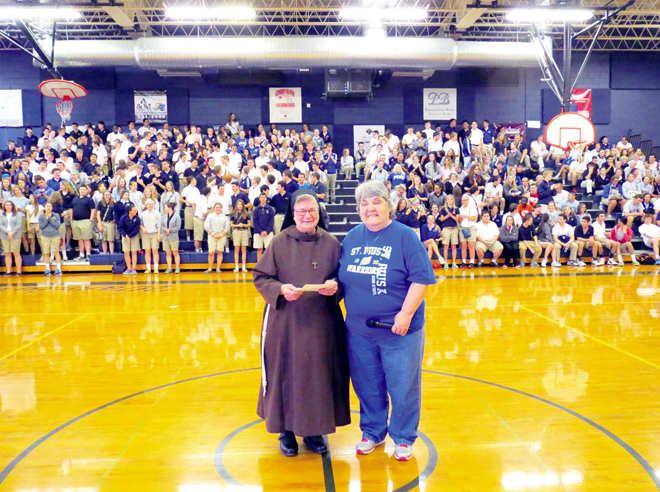![]()
![Bishop Robert W. Finn consecrates the Eucharist at the Memorial Mass for Bishop Raymond J. Boland at the Cathedral of the Immaculate Conception. Among the bishops concelebrating was Bishop Emeritus Kevin Boland of Savannah, Ga., right, brother of Bishop Raymond. (Joe Cory/Key photo)]()
Bishop Robert W. Finn consecrates the Eucharist at the Memorial Mass for Bishop Raymond J. Boland at the Cathedral of the Immaculate Conception. Among the bishops concelebrating was Bishop Emeritus Kevin Boland of Savannah, Ga., right, brother of Bishop Raymond. (Joe Cory/Key photo)
By Kevin Kelly
Catholic Key Associate Editor
KANSAS CITY — There was no better day to say good-bye than the Feast of the Annunciation.
Exactly 26 years ago that day, in the Cathedral of St. Paul, Msgr. Raymond James Boland was ordained Bishop Raymond James Boland, second bishop of the Diocese of Birmingham, Ala.
His younger brother, Bishop Emeritus J. Kevin Boland of Savannah, Ga., recalled the day vividly.
“It was a joyous day for our family,” Bishop Kevin told a pin-drop hushed congregation on March 25, who nearly filled Kansas City’s Cathedral of the Immaculate Conception to remember the man and bishop who served the Diocese of Kansas City-St. Joseph for nearly 21 years.
“Ray’s appointment sent minor shockwaves through the presbyterate in the USA,” he said in an accent both brothers shared. “Ray was the first Irish-born priest to be selected as a bishop for many decades.”
A special guest came that day — Cardinal Timothy Manning, archbishop emeritus of Los Angeles.
At the end of the ordination Mass, Cardinal Manning rose to speak. Twenty-six years later, Bishop Kevin Boland could relay his words verbatim:
“I waited for this day a long time,” the aging Cardinal said.
“Over the years, Ireland has gifted many U.S. dioceses with a multitude of priests. Today, that gift is crystallized with the ordination of Ray Boland as a bishop.”
Cardinal Manning then turned to the front pew, where the newly ordained Bishop Boland’s mother, Gertrude, and his three brothers Tony, Frank, and Father Kevin — still seven years away from his own ordination as a bishop — were seated.
“Mrs. Boland, this is a proud day for you,” Cardinal Manning said. “And I want your son Ray to remember that the (bishop’s) ring on his finger is only there because of the ring on your finger. God bless you.”
March 25, the Feast of the Annunciation was certainly a fitting day for the ordination, and also for the second and final diocese that Bishop Raymond Boland would serve as bishop to remember him, Bishop Kevin said.
“Mary was afraid when approached by the angel,” he said. “I am confident that Ray was afraid when the question was posed: ‘Will you accept the Holy Father’s appointment?’
“Obviously, he said yes, and chapter after chapter of service has unfolded over the next 26 years,” he said. “During these days, we close the covers on this remarkable journey and prayerfully usher in the promise of life eternal.”
Bishop Raymond James Boland died, according to his longstanding wishes, in his native Ireland. After his funeral, he was buried in the cemetery of the very parish, St. Michael’s in Tipperary Town, where his parents were married and his mother served until her death as a member of the Altar Society, and from which she sent two of her four sons to serve the church in missionary service to America.
Bishop Raymond James Boland was remembered on the Feast of the Annunciation, 2014, for his passion for the church, for his compassion for the poor, for his intellect, and for his sheer competence as a servant leader.
And he was remembered in grand style in the cathedral which was renovated and rededicated under his direction.
On that night in the spirit in that sacred place, Mass was celebrated by his successor, Bishop Robert W. Finn.
“We lost a good shepherd,” Bishop Finn said. “We pray that he will now intercede and help this diocese he loved to grow and prosper.”
![A long line of bishops process through an honor guard of Knights of Columbus and Knights of Peter Claver at the opening of the Memorial Mass for Bishop Raymond J. Boland. (Joe Cory/Key photo)]()
A long line of bishops process through an honor guard of Knights of Columbus and Knights of Peter Claver at the opening of the Memorial Mass for Bishop Raymond J. Boland. (Joe Cory/Key photo)
The celebration of Bishop Boland’s life was attended that evening by Knights — of Columbus, of Peter Claver and their ladies auxiliary, of Malta, of the Holy Sepulcher and the dames.
It was attended by the Ancient Order of Hibernians, and by the members of Serra International, who helped Bishop Boland foster vocations to religious life.
It was attended by dozens of priests and deacons of the diocese, and by bishops, including his two successors in Birmingham — Bishop Robert Baker and Bishop Emeritus David Foley, with whom Bishop Boland served as priests of the Archdiocese of Washington, D.C.
It was attended by Benedictine Abbot Gregory Polan of Conception Abbey.
It was attended by his fellow Missouri bishops — Bishop John Gaydos of Jefferson City, Bishop James Johnston and Bishop Emeritus John Leibrecht of Springfield-Cape Girardeau. It was attended by Bishop Michael Jackels, formerly of Wichita and now of Dubuque, Iowa. It was attended by Archbishop Joseph Naumann and Archbishop Emeritus James Keleher of Kansas City, Kan.
And it was, most of all, attended by the people whom he served, nearly filling the cathedral.
“I can hear him now — ‘This is way too much,’” said John Massman, one of Bishop Boland’s earliest, closest friends in Kansas City.
“He was a great man,” Massman said. “He was not only intelligent, he was sincere.”
Larry Moore, the now retired and legendary local television news anchor, was frequently tapped by Bishop Boland to lend his celebrity to a variety of Catholic charitable causes.
“You couldn’t say no to him,” Moore recalled. “He asked in such a loving way. He had all the characteristics Christ would have wanted a bishop to have.”
Pope Francis recently told the Catholic clergy to get out into the streets where the people are so they will be like shepherds, living with “the smell of the sheep.”
Bishop Boland didn’t need to be told.
As bishop, his residence was in a gated community, but not far from the midtown Kansas City parish of St. James.
Precious Blood Father Bill Hubmann, in a remembrance on the religious order’s Web page, recalled how Bishop Boland was a frequent volunteer at the parish’s food pantry and community kitchen, living out his call to serve and not to be served.
He even would occasionally volunteer, on a rare free weekend, to celebrate Sunday Mass at St. James, where Father Hubmann was pastor.
“One young man, whose mind had been altered by drugs, came up to him and said, ‘Mister Bishop, Mister Bishop. I always wanted to join the Catholic Church but my family won’t let me.’
“‘Are your shoes nailed to the floor?’ Bishop Boland asked him.
“‘No,’ said the young man.
“‘Well, if your shoes aren’t nailed to the floor, you can go anywhere you want.’”
Father Hubmann also recalled how at large gatherings, Bishop Boland would tell everyone in earshot, “Father Bill is my pastor.”
“I was never so honored,” Father Hubmann said.
Bishop Boland called them his “Sandwich Club.” Officially, they were the BLT — the Bishop’s Leadership Team.
One of them was Benedictine Sister Anne Shepard, now the prioress of her Mount St. Scholastica community in Atchison, Kan., in her service as superintendent of diocesan schools from 1994-2000.
Sister Anne recalled the day she told Bishop Boland that she must resign because her Benedictine community was calling her to leadership.
“The immediate words out of his mouth were, ‘I am going to miss the Benedictine influence at the top.’ That was the best professional compliment I have ever received,” Sister Anne said.
“He let his senior staff be senior staff, and that trust prompted excellence,” she said.
Father Patrick Rush, now pastor of Visitation Parish in Kansas City, served 10 years as Bishop Boland’s vicar general.
“He was a man of great intelligence,” Father Rush said.
“He had very strong opinions, and he would express them strongly at times,” he said. “But he was ready to take in new information and adjust his opinions. He was a great delegator, and he trusted his staff.”
![0404_BOLANDMass_Noonan]()
George Noonan, diocesan chancellor from 1994 to 2005, reads the Second Reading during the Memorial Mass for Bishop Raymond J. Boland. (Joe Cory/Key photo)
George Noonan, now in hospital administration in California, served Bishop Boland as chancellor for 10 years, the diocese’s first lay chancellor.
“One of his great strengths was that he tapped the gifts of people and utilized them in the way that was best for his administration,” Noonan said.
“But he let you use your competency, and he trusted you to do your job,” he said.
Noonan recalled Bishop Boland’s first opportunity to take a vacation in Ireland. He assembled his “Sandwich Club” and gave them a clear order — “Don’t call me unless the cathedral burns down. You are all competent people. You handle it.”
“You didn’t have to guess where you stood with him,” Noonan said.
Father Ernie Davis, administrator of St. Therese Little Flower and St. James parishes in Kansas City, was a former Episcopal priest whom Bishop Boland ordained as the first married priest in the diocese under a special papal pastoral provision.
He recalled how Bishop Boland welcomed him with open arms, but with reservations about how other priests would accept Father Davis.
“I knew what he wanted to do, but he didn’t want to do it without the support of his priests. He wasn’t afraid, but he wasn’t going to do it without his priests. So he told me that if it didn’t work out here, he would find another place for me to go,” Father Davis said.
Father Davis was ordained with the support of Bishop Boland’s priests.
Denise Kopek served as his administrative assistant for his entire tenure, both as active and retired bishop.
“He taught me so much,” she said. “You could ask him any question. I never met anybody who knew so much about everything.”
Bishop Boland was installed as bishop of Kansas City-St. Joseph on Sept. 9, 1993. On Sept. 8, Archbishop James P. Keleher was installed as archbishop of the Archdiocese of Kansas City in Kansas.
From the pulpit, on the day he was installed, Bishop Boland declared that on matters of the church in Kansas City, he and Archbishop Keleher would speak in unity, with one voice.
The two then-new Kansas City bishops knew each other, but not well. They didn’t have the opportunity to become friends until they both arrived simultaneously in the two Kansas Cities. One meeting before installations changed that, and both dioceses.
“It was clear to both of us that the situation before we came was that each diocese did its own thing and that there were few shared activities between us,” Archbishop Keleher said.
“Although we had hardly known each other, we soon decided with clear intentionality to be more cooperative as brothers across a narrow strip called the state line and at some points across the great (Missouri) river,” he said.
One of the first public signs of cooperation came the following January, as the two dioceses joined forces for a joint banquet and auction to raise money for Conception Seminary College in the Diocese of Kansas City-St. Joseph.
“We both needed an influx of priests,” Archbishop Keleher said. “Many seminarians of both dioceses studied at Conception, so we agreed to establish the SOS (Support Our Seminarians) dinner that aided our seminarians financially. It rallied the faithful on both sides of the line to become more aware of the need which they have supported enthusiastically.”
There were many other signs of cooperation, culminating in the 1997 National Catholic Youth Conference that was repeated in 2009, drawing thousands of young Catholics to downtown Kansas City, Mo., and requiring the talents and gifts of both dioceses.
Both Bishop Boland and Archbishop Keleher retired in 2005, succeeded by two priests of St. Louis who have continued the collaboration between the dioceses.
But on the Feast of the Annunciation, Archbishop Keleher’s thoughts turned to the Cathedral of the Immaculate Conception, renovated under Bishop Boland’s watch, and to the friend he has lost — for now.
“I pondered upon when the Good Shepherd will call me home to judgment,” the archbishop said. “I trust that my record before the Lord will resemble a little bit like Raymond’s.
“That will also be the day when I will be able once again to greet my good friend.”
Bishop Kevin Boland’s homily at his brother’s memorial Mass also recalled an earlier good-bye.
“It was late August 1957. The newly ordained Ray Boland, accompanied by his parents and siblings, boarded a tender at the Cobh docks to travel out to the cruise ship Mauritania anchored in Cork Harbor near Roche’s Point,” Bishop Kevin said.
“The time had come for Ray to depart for the USA. Another one of the Irish missionaries was departing for a foreign land.
“My abiding memory of that day was the convulsive tears of my father. He was saying good-bye to his eldest, proud beyond measure to be the father of a priest. Sadly, within five months, Ray would return to preside at our father’s funeral. He went to the Lord at the early age of 59,” Bishop Kevin said.
On Feb. 22, Bishop Raymond Boland would come home for the final time by an ambulance plane.
“He was admitted to Marymount hospice (in Cork) and peacefully, in the presence of family, took his final breath on Thursday, Feb. 27,” Bishop Kevin said.
According to his typically precise and poetically written instructions, Bishop Raymond James Boland, 82, was laid to rest at St. Michael’s Church, in Tipperary.
![Bishop Emeritus Kevin Boland laughes while describing his brother during the homily. (Joe Cory/Key photo)]()
Bishop Emeritus Kevin Boland laughes while describing his brother during the homily. (Joe Cory/Key photo)
“In homily preparation, it is not recommended to isolate one verse of Scripture to the detriment of the fuller text,” Bishop Kevin said.
“On this occasion, I will not follow the dictum. I quote one of the most consoling statements of Jesus: ‘And this is the will of the one who sent me, that I should not lose anything of what he gave me, but that I should raise it up on the last day.’
“Well, Jesus — you gave us Ray Boland,” Bishop Kevin said.
“He was your gift to us for the past 82 years,” he said.
“He was born in the shadows of the hills of Tipperary. He was laid to rest in the church yard of St. Michael’s,” he said.
“We believe in faith, that it is the will of your Father, that everyone who sees the Son and believes in him may have eternal life, and that he will raise you on the last day,” Bishop Kevin said.
“Ray was a story teller par excellence. His memory was a steel trap. He would blend people together, places and happenings of times long ago in such fashion that the impact in the present moment was life-giving and refreshing,” Bishop Kevin said.
“Ray was multi-faceted and multi-talented. He used these talents in service to the church. His friends constantly approached him, including myself, for assistance in this project or that project. He never failed to oblige,” he said.
“From childhood, he was a natural leader,” Bishop Kevin said. “There were four boys in the family. As adults, we had to practice to get together on an annual basis for a four- or five-day rendezvous — ‘Boys Night Out.’ It won’t be the same without Ray, but we will continue with three.”
Bishop Kevin then quoted the words of his older brother, written in 2001, to explain to the Diocese of Kansas City-St. Joseph why he is now resting in Ireland.
“Maybe this missionary should go home also, as it were, to complete the circle,” Bishop Raymond wrote.
“There are, of course, two circles. The smaller one confines our life to the finite circle of years; the larger one knows no bounds, beginningless and endless in that infinity which is the playground of our God,” he wrote.
“Some say one can’t go home again, but in reality, we all do. That is why, almost symbolically, I would like to be buried in Ireland.”
“March 4,” the day of the Irish funeral and burial of Bishop Raymond James Boland, Bishop Kevin said, “was another homecoming.”



